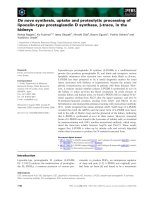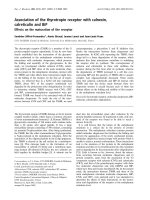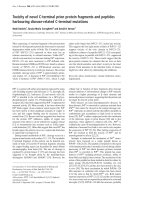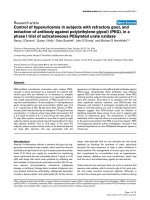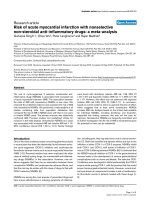Báo cáo y học: "De novo acute megakaryoblastic leukemia with p210 BCR/ABL and t(1;16) translocation but not t(9;22) Ph chromosome" pdf
Bạn đang xem bản rút gọn của tài liệu. Xem và tải ngay bản đầy đủ của tài liệu tại đây (503.31 KB, 22 trang )
Journal of Hematology &
Oncology
This Provisional PDF corresponds to the article as it appeared upon acceptance. Fully formatted
PDF and full text (HTML) versions will be made available soon.
De novo acute megakaryoblastic leukemia with p210 BCR/ABL and t(1;16)
translocation but not t(9;22) Ph chromosome
Journal of Hematology & Oncology 2011, 4:45
doi:10.1186/1756-8722-4-45
Xiao Min ()
Zhang Na ()
Liu YaNan ()
Li Chunrui ()
ISSN
Article type
1756-8722
Case report
Submission date
27 August 2011
Acceptance date
10 November 2011
Publication date
10 November 2011
Article URL
/>
This peer-reviewed article was published immediately upon acceptance. It can be downloaded,
printed and distributed freely for any purposes (see copyright notice below).
Articles in Journal of Hematology & Oncology are listed in PubMed and archived at PubMed Central.
For information about publishing your research in Journal of Hematology & Oncology or any BioMed
Central journal, go to
/>For information about other BioMed Central publications go to
/>
© 2011 Min et al. ; licensee BioMed Central Ltd.
This is an open access article distributed under the terms of the Creative Commons Attribution License ( />which permits unrestricted use, distribution, and reproduction in any medium, provided the original work is properly cited.
De novo acute megakaryoblastic leukemia with p210 BCR/ABL and t(1;16)
translocation but not t(9;22) Ph chromosome
Author: Xiao Min1, Zhang Na1, Liu Yanan1, Li Chunrui*1
Address: 1Department of Hematology, Tongji Hospital of Tongji Medical College,
Huazhong University of Science and Technology, 1095 Jie-Fang Avenue, Wuhan,
Hubei, 430030, P. R. China
E-mail: Xiao Min, ; Zhang Na, ; Liu Yanan,
; Li Chunrui,
*Corresponding author
Telephone: +86-27-83662680
Fax: +86-27-83662680
1
Abstract
Acute megakaryoblastic leukemia (AMKL) is a type of acute myeloid leukemia
(AML), in which majority of the blasts are megakaryoblastic. De novo AMKL in
adulthood is rare, and carries very poor prognosis. We here report a 45-year-old
woman
with
de
novo
AMKL
with
BCR/ABL
rearrangement
and
der(16)t(1;16)(q21;q23) translocation but negative for t(9;22) Ph chromosome. Upon
induction
chemotherapy
consisting
of
homoharringtonine,
cytarabine
and
daunorubicin, the patient achieved partial hematological remission. The patient was
then switched to imatinib plus one cycle of CAG regimen (low-dose cytarabine and
aclarubicin in combination with granulocyte colony-stimulating factor), and achieved
complete remission (CR). The disease recurred after 40 days and the patient
eventually died of infection. To the best of our knowledge, this is the first report of de
novo AMKL with p210 BCR/ABL and der(16)t(1;16)(q21;q23) translocation but not
t(9;22) Ph chromosome.
[Key words] Imatinib, Acute megakaryocytic leukemia, p210 BCR/ABL
2
Background
Acute megakaryoblastic leukemia (AMKL), also known as M7 under the
French-American-British (FAB) classification, represents <5% of acute myeloid
leukemia (AML) [1 - 3]. In adults, AMKL constitutes only 0.5% - 1% of de novo
AML cases [4]. Ph chromosome is a rare cytogenetic abnormality (≈ 1%) in AML [5,
6]. The incidence of t(9;22) in AMKL varies considerably in the literature: from
<20% to >60%, possibly due to inconsistency in the inclusion/exclusion of blastic
phase of chronic myeloid leukemia (CML) [7 - 9].
Here, we report a case of 45-year-old woman with de novo AMKL. Multiple reverse
transcription-polymerase chain reaction (RT-PCR) and Fluorescence in situ
hybridization (FISH) data indicating a BCR/ABL rearrangement, cytogenetics for
der(16)t(1;16)(q21;q23) but not t(9;22) Ph chromosome. Upon induction
chemotherapy consisting of homoharringtonine, cytarabine and daunorubicin, the
patient achieved partial hematological remission. The patient then received imatinib
plus one cycle of CAG regimen (low-dose cytarabine and aclarubicin in combination
with granulocyte colony-stimulating factor) [10], and achieved complete remission
(CR). The disease recurred after 40 days and the patient eventually died of infection.
The case diagnosis and management process, including the therapies, are summarized
in Table 1.
3
Case Presentation
A 45-year-old woman was hospitalized on May 16th, 2008 with two weeks of fatigue,
dizziness and low fever. The body temperature was 37.9 oC. On auscultation, a II/VI
systolic murmur was noticed over the apical region. The liver was palpable at 2 cm
below the ribcage. The spleen was palpable at 2 cm below the left costal margin.
Abdominal ultrasound confirmed slight hepatosplenomegaly. The patient had no
history of toxic substance exposure. Family history was non-remarkable.
Blood tests revealed a hemoglobin concentration of 63 g/L, a hematocrit of 23%, a
platelet count of 138 × 109/L. White blood cell count was 24 × 109/L, with 54%
megakaryoblasts, 17% promegakaryocytes, 10% myelocytes, 8% band forms, 7%
neutrophils, 3% lymphocytes, and 1% monocytes. Plasma D-dimer and lactate
dehydrogenase (LDH) were normal. A bone marrow smear showed 67.2%
megakaryoblasts and 20.4% promegakaryocytes. The megakaryoblasts were medium
to large-size with round, slightly irregular nuclei and one to three nucleoli (Figure 1a).
The cytoplasm of promegakaryocytes was basophilic and might show distinct
pseudopod formation (Figure 1b). Immunohistochemistry staining (Leukocyte
Phenotyping Kit, Sun BioTech, China) of these cells revealed a total of 55% positivity
for CD41 (Figure 1c) and 60% positivity for CD42b (Figure 1d), while CD13, CD14,
CD68, MPO, HLA-DR, CD10, CD19, CD3, CD5, and CD7 were all negative A bone
marrow biopsy indicated acute leukemia with myelofibrosis (Figure 1e &1f).
4
Cytogenetic analysis of trypsin R-banded chromosome preparations revealed 46, XX,
der(16)t(1;16)(q21;q23)[8]/46,XX[12] (Figure 2). To identify fusion genes, multiplex
reverse transcription-polymerase chain reaction (RT-PCR) was performed with 1~8
parallel nested (2-round) multiplex reactions in a thermocycler (Perkin-Elmer) to
achieve maximal sensitivity, as described in a previous study [11]. The E2A mRNA
was used as the internal positive control. The groups containing possible fusion genes
were further characterized using split-out PCR to identify the fusion pattern as
described previously [11]. The results suggested the presence of fusion among the
following genes: BCR, ABL and TEL (Figure 3a). A split-out PCR analysis was
performed using the individual primer sets BCR/ABL e1a2, BCR/ABL b2a2 or b3a2,
TEL/ABL. The results revealed fused BCR/ABL b2a2 mRNA expression (Figure 3b).
FISH analysis on interphase cells revealed an atypical signal pattern consisting of one
green signal, two orange signals, and one orange/green (yellow) fusion signal in
approximately 30% of the cells (Figure 3c).
On the basis of the above reported clinical and biological features, a diagnosis of de
novo acute AMKL. The patient received induction had regimen consisting of:
homoharringtonine (2 mg/m2/day on day 1 - 7), cytarabine (100 mg/m2/day on day 1 7) and daunorubicin (45 mg/m2/day on day 1 - 3). A bone marrow smear at one month
later showed no improvement. A partial remission was achieved after the induction
treatment was repeated. The patient then received imatinib (600 mg/d, p.o.) and one
5
cycle of CAG regimen (cytarabine 30 mg/day for 14 days, aclarubicin 10 mg/day on
days 1 - 8, and granulocyte colony-stimulating factor 300 μg/day on days 1 - 14).
Imatinib was discontinued after 2 weeks due to severe bone marrow suppression.
Plasma LDH and liver enzymes remained within the normal range during the
treatment. A complete hematological response was achieved upon evaluation at 50
days after initiating imatinib treatment, and the patient was discharged. She was
hospitalized for high fever and dyspnea after 40 days. Hemoglobin was 90 g/L. White
blood cell count was 19 × 109/L, with 21% blast cells. Relapse was established with
bone marrow smear. The patient was treated with cytarabine (2 g/m2/day on days 1 - 3)
and daunorubicin (45 mg/m2/day on days 1 - 3), with no apparent improvement. She
died of fungal infection after 27 days.
Conclusions
Although the first AMKL was described as early as 1931, reports have been sporadic
because of both the rarity of the disease and the lack of well-established diagnostic
criteria. In fact, precise diagnostic criteria were added to the French-American-British
classification only in 1985 (FAB M7) [1]. The bone marrow aspirate shows a
leukemic cell infiltrate that comprises 30% or more of all cells. These cells are
identified as being of megakaryocyte lineage by platelet peroxidase reaction on
electron microscopy or by tests with monoclonal or polyclonal platelet-specific
antibodies (CD41a, CD42 or CD61). Myelofibrosis or increased bone marrow
6
reticulin are a prominent aspect in most AMKL patients. In some cases,
megakaryoblastic crisis could be the first presentation of CML, and not
distinguishable from de novo AMKL [12 - 16]. This case represents de novo AMKL
in our opinion, because the patient had no basophilia and eosinophilia upon
presentation, which are often seen in blast crisis of CML [17]. Basophilia, a frequent
feature of blast crisis, is uncommon in acute leukemias [18]. Furthermore, our patient
had only mild splenomegaly. Moderate or severe splenomegaly is common in blast
crisis of CML [13, 16].
AMKL is associated with no specific cytogenetic abnormality, and the majority of
cases present with a complex karyotype. In a recent study by Le Groupe Francais de
Cytogenetique Hematologique (GFCH), complex karyotypes of unbalanced changes,
such as -5/del5q or -7/del(7q), 3q21q26, dic(1;15)(p11;p11), inv(4)(p15q11),
t(14;21)(q24;q22), der(7)t(7;17)(q11;q11) and t(6;13)(p22;q14), were common in
adult de novo AMKL [8]. In addition, the t(X;16) translocation has also been reported
in 2 adult de novo AMKL cases [8]. One translocation was 46,XY,t(16;21)(p11;q22),
another was t(16;16)(p13;q22). The present case serves to identify a novel
translocation der(16)t(1;16)(q21;q23), providing further insight into the heterogeneity
of genomic rearrangement in this subset of AML.
Data concerning the incidence of the Ph chromosome or BCR/ABL rearrangement in
de novo AMKL are scarce. The Ph chromosome is one of the most common
7
chromosomal abnormalities associated with adult AMKL according the report of the
GFCH [8]. For example, Ph chromosome was found in four out of a total of 23
AMKL cases (17%) [8]. In fact, only two cases were de novo AMKL (9%). In an
early study of 14 AMKL patients with cytogenetic data, Ph chromosome was found in
two cases of megakaryoblastic transformation of chronic myelogenous leukemia, but
not in de novo AMKL [7]. Ohyashiki et al. reported three cases with AMKL, but none
had Ph chromosome [9].
Reports of Ph chromosome or BCR/ABL rearrangement are summarized in Table 2.
Cases were heterogeneous and the survival was from 1.9 to 96 months. The case
reported by Kaloutsi et al. [20] was a 24-year-old male with de novo AMKL.
Interestingly, cytogenetics revealed a t(10;22), which by FISH, was found to be a
variant Philadelphia translocation involving chromosome 10q. The FISH result in our
case revealed an atypical signal pattern: one yellow fusion signal with one green and
two orange signals (Figure 3c). This result confirmed that the detected variant
translocation involved fragments of two chromosomes: 9 and 22. The ABL orange
signals occurred on both chromosomes 9 and on der(9)ins(22;9) and one BCR green
signal on chromosomes 22 and one yellow fusion signal on der(22)ins(22;9).
To the best of our knowledge, this is the first report of de novo AMKL with rare
variant of Philadelphia rearrangement and a novel translocation
der(16)t(1;16)(q21;q23). Our case and the case reported by Kaloutsi et al. [20]
8
suggested that the FISH should be considered for detection of variant Philadelphia
rearrangement in de novo AMKL patients.
9
Consent
Written informed consent was obtained from the husband of the patient for
publication of this case report and any accompanying images. A copy of the written
consent is available for review by the Editor-in-Chief of this journal.
Competing interests
The authors declare that they have no competing interests.
Authors’ contributions
XM was responsible for data acquisition and analyses, as well as data interpretation.
ZN participated in manuscript preparation and contributed significantly to the concept
development. LYN participated in patient management, and also contributed to data
interpretation. LCR was responsible of patient management and conceived the study.
All authors read and approved the final manuscript.
Acknowledgements
This work was supported in part by the Nature Science Foundation Committee
(#30800402).
10
References
1.
Bennett JM, Catovsky D, Daniel MT, Flandrin G, Galton DA, Gralnick HR,
Sultan C: Criteria for the diagnosis of acute leukemia of megakaryocyte
lineage (M7). A report of the French-American-British Cooperative Group.
Ann Intern Med 1985, 103:460-462.
2.
San Miguel JF, Gonzalez M, Cañizo MC, Ojeda E, Orfao A, Caballero MD, Moro
MJ, Fisac P, Lopez Borrasca A: Leukemias with megakaryoblastic
involvement: clinical, hematologic, and immunologic characteristics. Blood
1988, 72:402-407.
3.
Tallman MS, Neuberg D, Bennett JM, Francois CJ, Paietta E, Wiernik PH,
Dewald G, Cassileth PA, Oken MM, Rowe JM: Acute megakaryocytic leukemia:
the Eastern Cooperative Oncology Group experience. Blood 2000,
96:2405-2411.
4.
Castoldi GL, Liso V, Fenu S, Vegna ML, Mandelli F: Reproducibility of the
morphological diagnostic criteria for acute myeloid leukemia: the GIMEMA
group experience. Ann Hematol 1993, 66:171-174.
5.
Cuneo A, Ferrant A, Michaux JL, Demuynck H, Boogaerts M, Louwagie A,
Doyen C, Stul M, Cassiman JJ, Dal Cin P, Castoldi G, Van den Berghe H:
Philadelphia
chromosome-positive
acute
myeloid
leukemia:
cytoimmunologic and cytogenetic features. Haematologica 1996, 81:423-427.
6.
Buchdunger E, Cioffi CL, Law N, Stover D, Ohno-Jones S, Druker BJ, Lydon
NB: Abl protein-tyrosine kinase inhibitor STI571 inhibits in vitro signal
11
transduction mediated by c-kit and platelet-derived growth factor receptors.
J Pharmacol Exp Ther 2000, 295:139-145.
7.
Cuneo A, Mecucci C, Kerim S, Vandenberghe E, Dal Cin P, Van Orshoven A,
Rodhain J, Bosly A, Michaux JL, Martiat P: Multipotent stem cell involvement
in megakaryoblastic leukemia: cytologic and cytogenetic evidence in 15
patients. Blood 1989, 74:1781-1790.
8.
Dastugue N, Lafage-Pochitaloff M, Pagès MP, Radford I, Bastard C, Talmant P,
Mozziconacci MJ, Léonard C, Bilhou-Nabéra C, Cabrol C, Capodano AM,
Cornillet-Lefebvre P, Lessard M, Mugneret F, Pérot C, Taviaux S, Fenneteaux O,
Duchayne E, Berger R; Groupe Franỗais d'Hematologie Cellulaire: Cytogenetic
profile of childhood and adult megakaryoblastic leukemia (M7): a study of
the Groupe Franỗais de Cytogénétique Hématologique (GFCH). Blood 2002,
100:618-626.
9.
Ohyashiki K, Ohyashiki JH, Hojo H, Ohtaka M, Toyama K, Sugita K, Nakazawa
S, Sugiura K, Nakazawa K, Nagasawa T, Enomoto Y, Watanabe Y: Cytogenetic
findings in adult acute leukemia and myeloproliferative disorders with an
involvement of megakaryocyte lineage. Cancer 1990, 65:940-948.
10. Saito K, Nakamura Y, Aoyagi M, Waga K, Yamamoto K, Aoyagi A, Inoue F,
Nakamura Y, Arai Y, Tadokoro J, Handa T, Tsurumi S, Arai H, Kawagoe Y,
Gunnji H, Kitsukawa Y, Takahashi W, Furusawa S: Low-dose cytarabine and
aclarubicin in combination with granulocyte colony-stimulating factor (CAG
regimen) for previously treated patients with relapsed or primary resistant
12
acute myelogenous leukemia (AML) and previously untreated elderly
patients with AML, secondary AML, and refractory anemia with excess
blasts in transformation. Int J Hematol 2000, 71:238-244.
11. Pallisgaard N, Hokland P, Riishøj DC, Pedersen B, Jørgensen P: Multiplex
reverse transcription-polymerase chain reaction for simultaneous screening
of 29 translocations and chromosomal aberrations in acute leukemia. Blood
1998, 92:574-588.
12. Campiotti L, Grandi AM, Biotti MG, Ultori C, Solbiati F, Codari R, Venco A:
Megakaryocytic blast crisis as first presentation of chronic myeloid leukemia.
Am J Hematol 2007, 82:231-233.
13. Pelloso LA, Baiocchi OC, Chauffaille ML, Yamamoto M, Hungria VT, Bordin JO:
Megakaryocytic blast crisis as a first presentation of chronic myeloid
leukemia. Eur J Haematol 2002, 69:58-61.
14. Al-Shehri A, Al-Seraihy A, Owaidah TM, Belgaumi AF: Megakaryocytic blast
crisis at presentation in a pediatric patient with chronic myeloid leukemia.
Hematol Oncol Stem Cell Ther 2010, 3:42-46.
15. Pullarkat ST, Vardiman JW, Slovak ML, Rao DS, Rao NP, Bedell V, Said JW:
Megakaryocytic blast crisis as a presenting manifestation of chronic myeloid
leukemia. Leuk Res 2008, 32:1770-1775.
16. Bryant BJ, Alperin JB, Elghetany MT: Paraplegia as the presenting
manifestation of extramedullary megakaryoblastic transformation of
previously undiagnosed chronic myelogenous leukemia. Am J Hematol 2007,
13
82:150-154.
17. Vardiman JW, Harris NL, Brunning RD: The World Health Organization
(WHO) classification of the myeloid neoplasms. Blood 2002, 100:2292-2302.
18. Peterson LC, Bloomfield CD, Brunning RD: Blast crisis as an initial or
terminal manifestation of chronic myeloid leukemia. A study of 28 patients.
Am J Med 1976, 60:209-220.
19. Balatzenko G, Guenova M, Zechev J, Toshkov S: Acute megakaryoblastic
leukaemia with extreme thrombocytosis and p190 (bcr/abl) rearrangement.
Ann Hematol 2004, 83:381-385.
20. Kaloutsi V, Hadjileontis C, Tsatalas C, Sambani C, Kostopoulos I, Papadimitriou
C: Occurrence of a variant Philadelphia translocation, t(10;22), in de novo
acute megakaryoblastic leukemia. Cancer Genet Cytogenet 2004, 152:52-55.
21. Corm S, Renneville A, Rad-Quesnel E, Grardel N, Preudhomme C, Quesnel B:
Successful treatment of imatinib-resistant acute megakaryoblastic leukemia
with e6a2 BCR/ABL: use of dasatinib and reduced-conditioning stem-cell
transplantation. Leukemia 2007, 21:2376-2377.
22. Ahmad F, Dalvi R, Das BR, Mandava S: Novel t(8;17)(q23;q24.2) and
t(9;22)(p24.1;q12.2) in acute megakaryoblastic leukemia AML-M7 subtype
in an adult patient. Cancer Genet Cytogenet 2009, 193:112-115.
14
Figure legends:
Figure 1. Diagnosis of acute megakaryoblastic leukemia. a. Bone marrow smear
revealed many medium to large-size megakaryoblasts. The yellow arrow indicates
megakaryoblasts (1000 ×). b. Bone marrow smear revealed many large-size
promegakaryocytes. The cytoplasm of promegakaryocytes shows distinct pseudopod
formation (1000 ×). The red arrow indicates the promegakaryocytes. c, d.
Immunohistochemistry staining of CD41 (c) and CD42b (d) of bone marrow smears
(1000 ×). The positivity was shown by the red precipitates in plasma or membrane. e.
Bone marrow biopsy showing diffuse bone marrow infiltration of medium-size
megakaryoblasts (1000 ×). The blue arrow indicates the megakaryoblasts. f. Bone
marrow biopsy showing myelofibrosis (100 ×). The white arrow indicates
myelofibrosis.
Figure 2.
Representative karyogram
of
bone marrow
cell
showing the
46,XX,der(16)t(1;16)(q21;q23).
Figure 3. Detection of fusion genes. a. Multiplex reverse transcription-PCR analysis
showed that the cells of this patient were positive for a translocation in multiplex
reaction 6 (The arrow). Internal positive control: E2A (690bp). The primer sets used
in multiplex reverse transcription-PCR were chosen as described previously [11] to
detect the following fusion genes: 1. CBFβ /MYH11 /MLL /AFX1 /AF6 /ELL /E2A;
2. MLL /AF1P /AF17 /AF10 /E2A; 3. PBX1 /SIL /TAL1 /HLF /TEL /AML1A /E2A;
4. AML1A /AMLMDSEVI /HOX11 /ETO /TLS /ERG /E2A; 5. MLL /AF4 /AF9
/AF1Q /ENL /E2A; 6. BCR /ABL /TEL /E2A; 7. DEK /CAN /SET /AMLMDSEVI
15
/E2A; 8. PLZF /PML3 /RARα /NPM /NPMALK /MLF1 /E2A; b. The split-out PCR
analysis revealed a BCR/ABL b2a2 fusion gene expression using primer sets for 1.
BCR/ABL e1a2 (320bp); 2. BCR/ABL b2a2 (472bp) and BCR/ABL b3a2 (397bp); 3.
TEL/ABL (366bp); c. Fluorescence in situ hybridization (FISH) using a Vysis LSI
BCR/ABL Dual Color, Dual Fusion Translocation Probe (Vysis, Downers Grove, IL,
USA) on an interphase cell. Orange signal is ABL gene on chromosome 9 and green
signal is BCR gene on chromosome 22. The ABL orange signals occurred on both
chromosomes 9 and on der(9)ins(22;9) and one BCR green signal on chromosomes 22
and one yellow fusion signal on der(22)ins(22;9). The arrow indicates the fusion
signal.
16
Table 1. The clinical course of the patient
Time
Management process
Diagnosis established;
d1
Induction chemotherapy consisting of homoharringtonine, cytarabine and
(3/20)
daunorubicin began.
Bone marrow smear showed 20.4% megakaryoblasts and 24.8% promegakaryocytes
d30
(chemotherapy failure);
Second induction chemotherapy.
Bone
d60
marrow
smear
showed
6%
megakaryoblasts
and
11%
promegakaryocytes (partial remission);
Imatinib treatment started (600 mg/d) and CAG regimen
d67
WBC: 3.5 × 109/L.
d69
Imatinib reduced to 400 mg/d.
d75
Imatinib discontinued (WBC: 0.9 × 109/L).
Imatinib restarted (200 mg/d);
d102
WBC: 4.3 × 109/L (d106)
Imatinib increased to 400 mg/d
d107
d110: complete hematological remission
WBC:3.2 × 109/L (d110) ; 3.5 × 109/L (d120); 4.2 × 109/L (d130)
d132
Imatinib discontinued (due to financial reasons)
d150
Relapse.
d177
Patient deceased.
Abbreviations: d, day; CAG regimen: cytarabine 30 mg/day for 14 days, aclarubicin
10 mg/day on days 1 - 8, and granulocyte colony-stimulating factor 300 µg/day on
days 1 - 14; WBC, white blood cell count.
17
Table 2. Literature review of Ph chromosome or BCR/ABL rearrangement in de
novo acute megakaryoblastic leukemia
Case
Sex/Age
BCR/ABL fusion
Survival
transcripts
(month)
Cytogenetic changes
No.
(years)
1
F/58
47,XX,+8,t(9;22)(q34;q11)
Reference
P190 BCR/ABL
6
Balatzenko, et al [19]
Not provided
27
Dastugue, et al [8]
Not provided
27
Dastugue, et al [8]
Not provided
1.9
Dastugue, et al [8]
46,XX,t(9;22)(q34;q11)[12]/(4n)
2
F/72
92,XXXX,t(9;22)x2[10]/(8n)184,
XXXXXXXX,t(9;22)x4[4]
3
F/51
4
46,XX,t(9;22)(q34;q11)[25]
F/44
46,XX,inv(3)(q21q26)[4]/46,idem
,t(9;22)(q34;q11)[15]
46,XY,t(10;22)(q26;q11)
5
M/24
Not
Not provided
FISH: t(9;22);10q
Kaloutsi, et al [20]
provided
46,XX,t(9;22)(q34;q11),del(18)(p
6
M/53
BCR/ABL e6a2
96
Corm, et al [21]
10)[15]
t(9;22)(p24.1;q12.2)
7
M/39
t(8;17)(q23;q24.2).
18
Not
Not provided
Ahmad , et al [22]
provided
Figure 1
Figure 2
Figure 3
